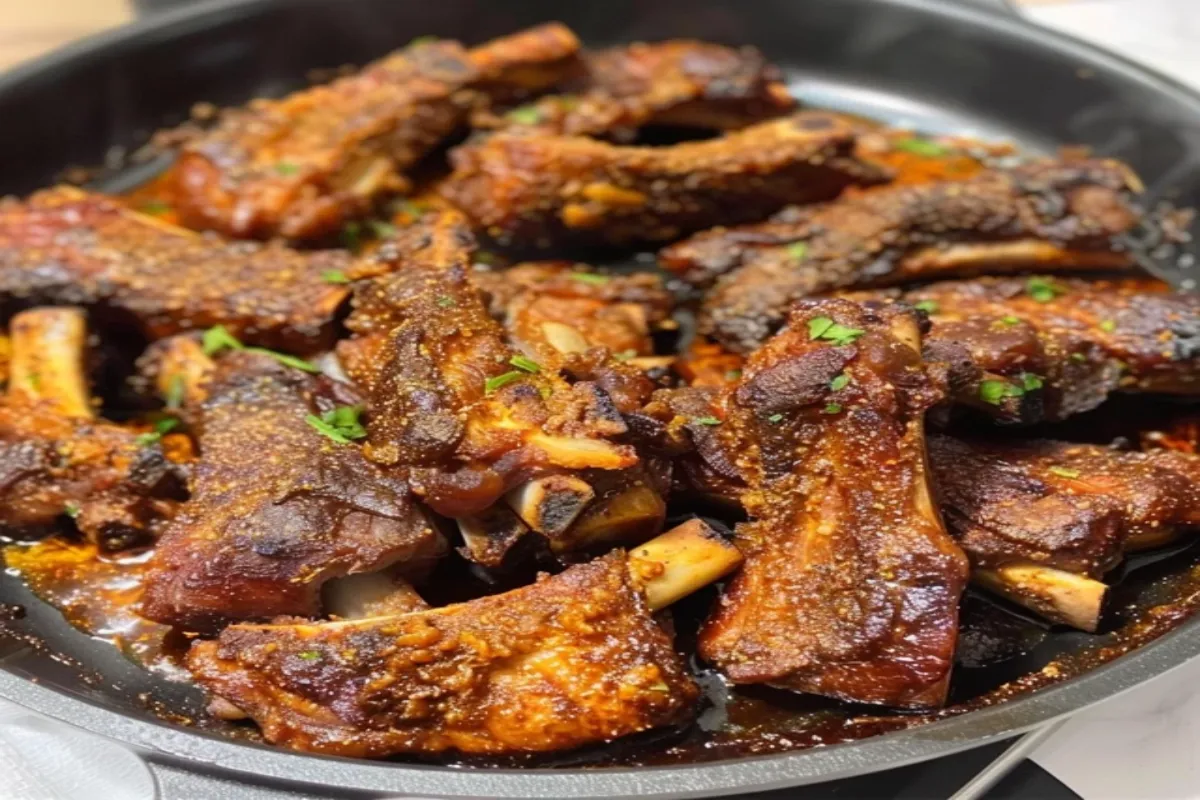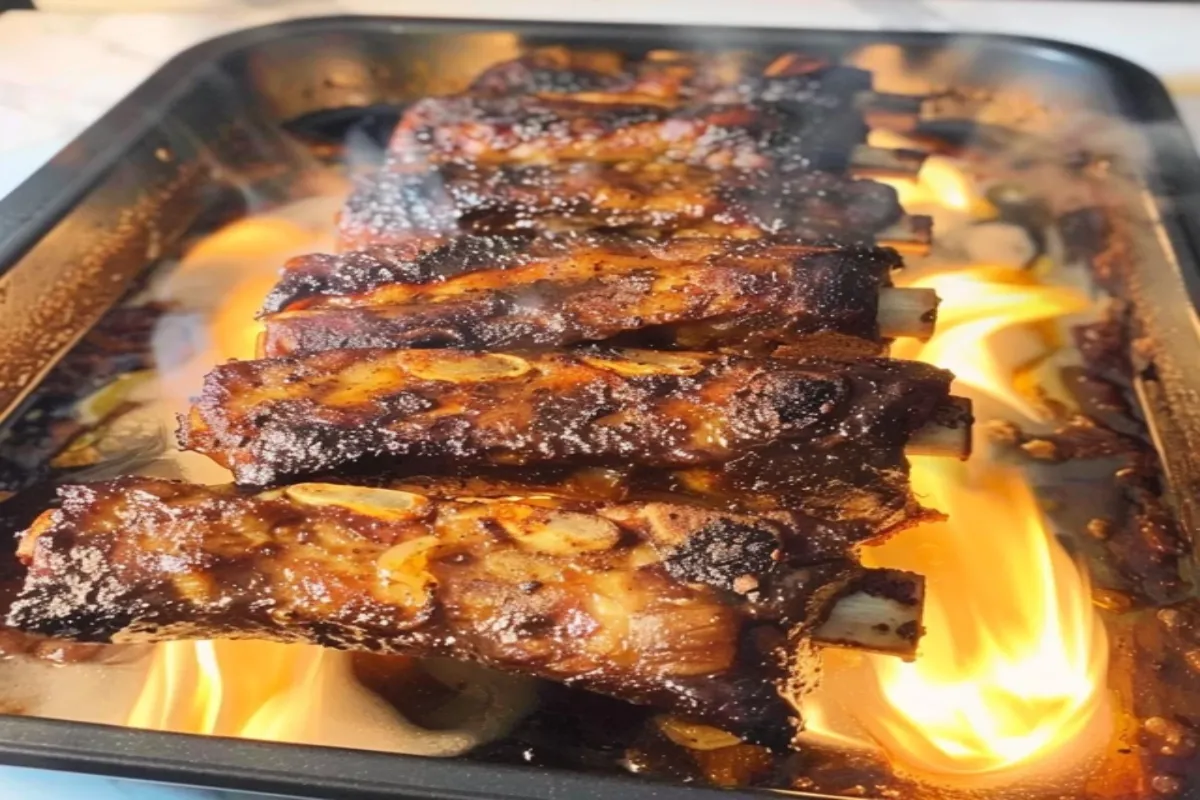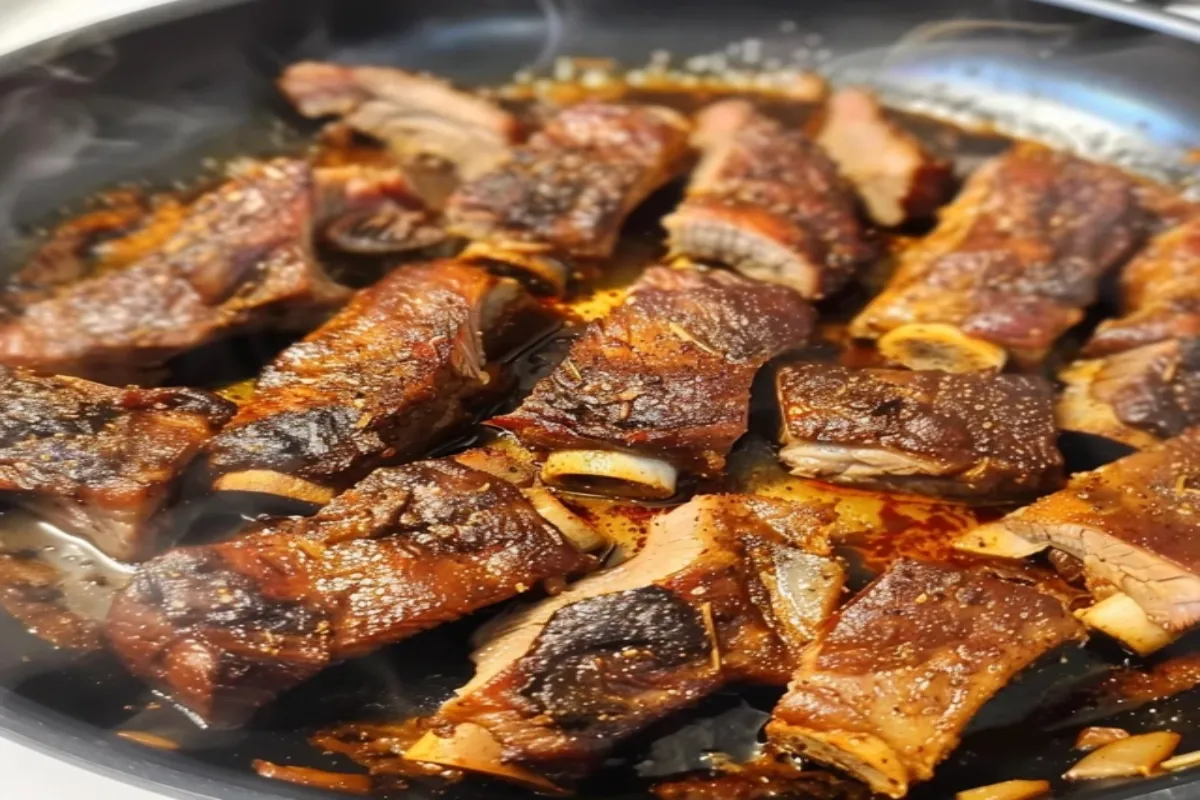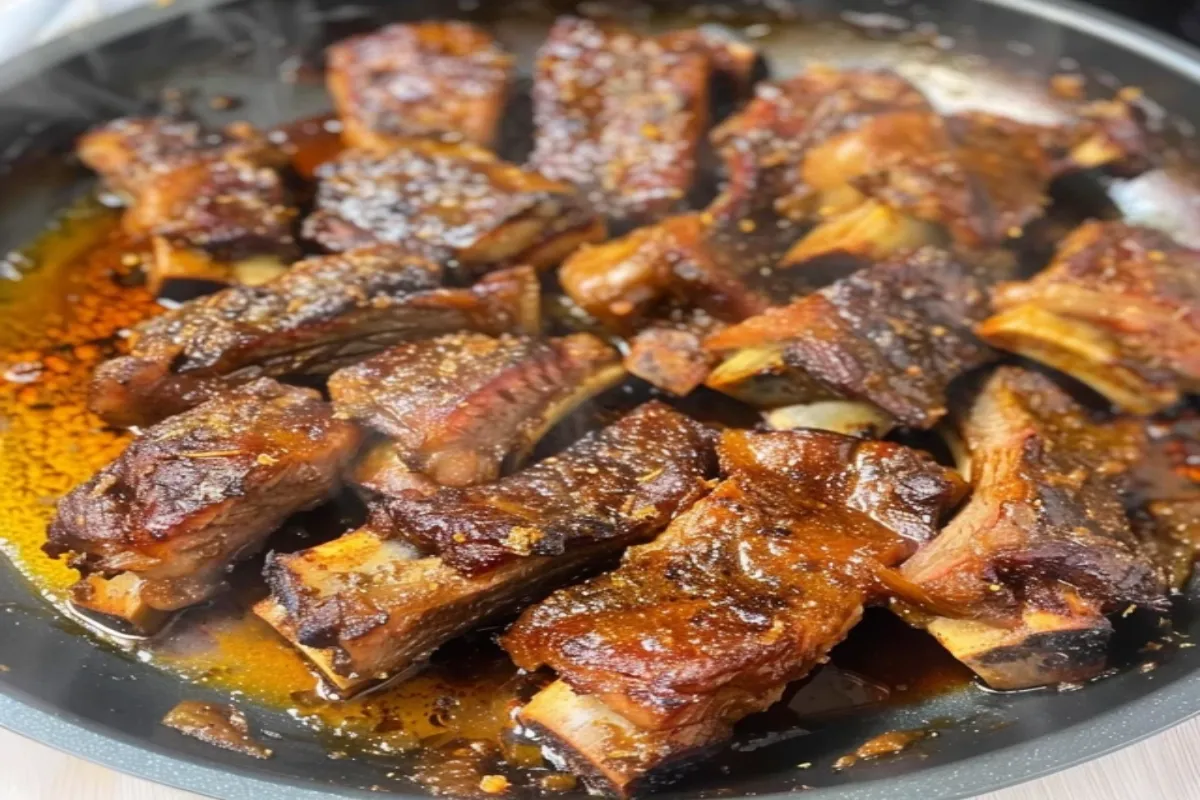This article explores the cooking of country-style ribs. We’ll discover whether they become more tender with longer cooking times. Let’s dive into the art of cooking ribs!
Understanding Country Style Ribs
Country-style ribs, despite their name, are not actually ribs in the traditional sense. Indeed, they’re cut from the blade end of the pork loin, often from near the shoulder. These meaty cuts naturally offer a good balance of fat and muscle. Furthermore, this combination makes them incredibly flavorful. Moreover, cooking them properly is crucial for a tender result. Understanding the nature of the cut is the first step towards success.
Anatomy of a Country-Style Rib
Firstly, it is essential to know their composition. Country style ribs feature a good amount of connective tissue. Secondly, this tissue is what can make them tough if not cooked appropriately. Thirdly, the presence of marbling helps keep them moist and flavorful. However, even with marbling, they require low and slow cooking. Consequently, this approach breaks down the collagen. Therefore, this process results in that tender, fall-off-the-bone experience.
The Science of Tenderness: How Cooking Affects Ribs
The key to transforming tough ribs into tender ones lies in how heat affects their proteins and connective tissues. Cooking time is a crucial element in this process. Furthermore, the longer they cook, the more collagen breaks down into gelatin. Gelatin is indeed what creates the desired melt-in-your-mouth texture. Moreover, cooking method plays a vital role as well.
The Role of Collagen
Collagen is a tough protein found in meat. Initially, when raw, it’s quite rigid. However, with prolonged exposure to heat, collagen undergoes a transformation. Subsequently, this change makes it softer and more palatable. Therefore, this explains why slow cooking works wonders. Likewise, this is particularly true for cuts like country-style ribs.
Heat’s Impact on Meat Fibers
The heat affects not just collagen but also the muscle fibers. Muscle fibers initially contract when exposed to high heat. Additionally, this can lead to toughness. However, with gentle and slow cooking, these fibers gradually relax. Therefore, the meat becomes more tender and juicy. Consequently, the timing and temperature need to be carefully controlled.
Cooking Methods and Tenderness
Several cooking methods are effective for breaking down the connective tissue naturally in country-style ribs. Each method uses different approaches to achieve tenderness. Furthermore, they all rely on low heat and longer cooking times. It’s all about getting those ribs incredibly tender.
Slow Cooking Techniques
Slow cooking, whether in a slow cooker or Dutch oven, is a foolproof way to ensure tenderness. Slow cookers use low heat over an extended period, which gently breaks down the collagen. Moreover, this approach works particularly well for tougher cuts. For example, country-style ribs greatly benefit.
Braising Methods
Braising involves searing the ribs first. Then, they’re cooked in liquid at a low temperature. Braising combines the advantages of searing and stewing. This process builds flavor and tenderizes the meat simultaneously. As a result, this method produces juicy, flavorful, and naturally tender ribs.
Grilling with Indirect Heat
While grilling often uses high heat, indirect grilling on a low temperature is also effective for tenderizing ribs. The key is to cook them away from the direct flame. Subsequently, this prevents the meat from drying out. However, it still allows it to cook slowly and evenly. Additionally, you will achieve tender and smoky results this way.
Time vs. Tenderness: What’s the Sweet Spot?
There isn’t a universal ideal cooking time since several factors come into play. For example, the size of the ribs matters. Also, the cooking method and the desired level of tenderness also have an impact. Nonetheless, there are general guidelines to follow.
Estimating Cooking Time
In general, you should allow for several hours of slow cooking for country style ribs. For slow cookers or braising, 3-4 hours is common. The goal is to reach an internal temperature where the meat feels easily pierced with a fork. Moreover, you should note that every cooking time depends on the thickness of the meat.
Recognizing When Ribs are Done
The best way to tell if ribs are tender enough is by their texture. When the meat easily pulls apart or falls off the bone, they’re done. You should ensure the internal temperature reaches 195-205°F for optimal tenderness. Therefore, using a meat thermometer is essential for accuracy.
The Impact of Overcooking
While cooking for a long time is vital for tenderness, there is a point where overcooking can become an issue. Overcooked ribs can become dry or mushy. It’s important to find the right balance. Therefore, the right timing is essential for great results.
Preventing Dryness
To prevent ribs from drying out, always cook them in a liquid or ensure they are well wrapped in foil. This helps them to retain moisture during the cooking process. The inclusion of natural fats helps to keep them moist. For example, marbling within the meat contributes to moisture retention.
Avoiding Mushy Ribs
Mushy ribs occur if the meat is cooked for far too long or at too high of a temperature. To avoid this, monitor cooking time and temperature carefully. Also, periodically check the meat’s tenderness during cooking.
Ingredients That Enhance Tenderness
Besides cooking techniques, certain ingredients can help tenderize country-style ribs. These ingredients work in various ways. For example, some help to break down proteins, while others add moisture. It’s all part of the process of achieving the ultimate tender result.
Acidic Marinades
Marinades containing acidic components like vinegar, lemon juice, or wine are excellent. These ingredients help to break down muscle fibers, resulting in naturally tender ribs. Additionally, marinades impart a delicious flavor. For instance, soy sauce can be used for that purpose.
Salt’s Role
Salt is not only a flavor enhancer but also a tenderizer. Salt helps to break down the proteins in the meat, resulting in a softer texture. Additionally, dry brining with salt is a great method to tenderize the meat prior to cooking.
Recipe for Tender Country Style Ribs
Here is a simple recipe to cook naturally tender country-style ribs. This method focuses on slow cooking, to produce fall-off-the-bone results. Therefore, you can use the following recipe as a foundation.
Ingredients
-
2-3 lbs country style ribs
-
1 tablespoon olive oil
-
1 onion, chopped
-
2 cloves garlic, minced
-
1 cup beef broth
-
1/2 cup tomato sauce
-
1/4 cup Worcestershire sauce
-
1 tablespoon brown sugar
-
1 teaspoon smoked paprika
-
1/2 teaspoon salt
-
1/4 teaspoon black pepper
Instructions
-
Firstly, heat olive oil in a large Dutch oven or skillet over medium-high heat.
-
Secondly, sear the country style ribs on all sides until browned.
-
Thirdly, remove the ribs and set them aside.
-
Fourthly, add onion and garlic to the pot. Sauté until softened.
-
Next, stir in the beef broth, tomato sauce, Worcestershire sauce, brown sugar, paprika, salt, and pepper.
-
Afterward, return the ribs to the pot.
-
Subsequently, bring the mixture to a simmer.
-
Then, cover the pot and transfer it to a preheated oven at 325°F.
-
Lastly, braise for 3-4 hours, or until the ribs are very tender. Ensure the meat easily pulls apart.
Serving Suggestions
Serve these tender ribs with your favorite side dishes. For example, mashed potatoes, coleslaw, or roasted vegetables are all great options. Enjoy your naturally tender and flavorful ribs!
Troubleshooting Tough Ribs
If your ribs are still tough after cooking, it may be due to several factors. It is helpful to identify the cause, so you can avoid it next time. Fortunately, most issues are fixable.
Common Mistakes
One of the most common mistakes is not cooking the ribs long enough. In addition, insufficient liquid can also lead to tough results. Also, cooking at too high a temperature can be a problem as well. Therefore, it is vital to review your technique.
Adjusting the Cooking Process
If your ribs are tough, you may need to add more liquid. You should continue to braise them at a lower temperature. If you have cooked them for a long time, consider adding a bit more liquid and let them simmer for an extra hour or so. Therefore, patience is crucial.
Different Cuts of Ribs and Their Tenderness
There are different cuts of ribs and they all cook differently. For instance, spareribs and baby back ribs behave differently compared to country style ribs. So, it is crucial to understand what you’re working with.
Spareribs vs. Baby Back Ribs
Spareribs, cut from the belly side of the pig, are larger and more flavorful. Conversely, baby back ribs are smaller and leaner. Each type has its optimal cooking times and methods for maximum tenderness. Furthermore, the fat content of the cut also plays a big role in cooking time and results.
How They Differ from Country-Style Ribs
While spareribs and baby back ribs have bones, country-style ribs don’t. Moreover, country-style ribs are meatier, which affects their cooking times. The meat composition of the cut is the single biggest factor in cook times. Consequently, the techniques will differ somewhat based on this factor.
Making the Most of Your Country Style Ribs
Once you’ve mastered the art of cooking tender country-style ribs, you can experiment with flavors and methods. They’re a versatile cut that can adapt to many different flavor profiles and cooking styles. Therefore, they can become a staple on your family table.
Exploring Different Flavor Profiles
From smoky BBQ rubs to tangy sauces, the possibilities for flavoring ribs are endless. Try different herbs and spices or even sweet and savory combinations. The natural flavors of the pork can be combined with so many options.
Leftover Ideas
Use leftover ribs in sandwiches, tacos, or even salads. Pulled rib meat is great for these kinds of dishes. Also, don’t throw away those bones. They’re great for enriching stocks and soups. Additionally, every part of your cook can have a use.
Additional Tips for Achieving Maximum Tenderness
Here are some extra tips to help you consistently achieve fall-off-the-bone tender ribs. These tips will ensure you cook perfect ribs every single time. Thus, following these practices will pay dividends.
The Importance of Rest
Allow your ribs to rest after cooking. This allows the juices to redistribute, resulting in a more flavorful and moist outcome. Resting is a step many tend to forget, but it’s important for optimal results. It will make sure your ribs are naturally tender.
Using a Meat Thermometer
A meat thermometer is a must-have for accurate cooking. It ensures the meat reaches the safe internal temperature while also ensuring tenderness. By using a thermometer you can be confident that your ribs are cooked just right.
Seasoning and Flavor Enhancements for Country Style Ribs
While cooking for tenderness is crucial, don’t forget the importance of flavor. Seasoning ribs properly enhances the natural flavor of the pork. Therefore, a good balance of herbs, spices, and other seasonings will elevate your ribs to the next level.
Dry Rubs
Dry rubs are a blend of spices and herbs applied directly to the meat before cooking. Some great options are paprika, brown sugar, garlic powder, onion powder, and chili powder. These rubs infuse the ribs with flavor. Furthermore, dry rubs create a great bark during the cooking process.
Marinades
Marinades not only impart flavor but also tenderize the meat through acidic components. A marinade might include soy sauce, vinegar, garlic, ginger, and spices. Therefore, marinating for a few hours will improve the texture and taste of your ribs.
Cooking Temperatures for Perfect Ribs
The cooking temperature is important in achieving tender results. Too high and your ribs will be tough. Conversely, too low, and they will not cook through. Therefore, finding the sweet spot is critical.
Low and Slow Cooking
Low and slow is generally the ideal way to cook ribs. Keeping the temperature around 275-325°F allows the collagen to break down. The low temperature prevents the meat from drying out. Additionally, that is what allows the meat to become tender and juicy.
The Role of Heat Control
Maintaining a consistent temperature is vital. If cooking on a grill, use indirect heat. Additionally, if you are using a slow cooker, make sure you are using the proper setting. These small details all help to get your ribs perfectly tender.
Table 1: Comparison of Cooking Methods
| Method | Temperature | Time | Tenderness Level |
| Slow Cooker | Low (200-225°F) | 3-5 hours | Very Tender |
| Braising | Low (325°F) | 2.5-4 hours | Very Tender |
| Indirect Grilling | Low (275-300°F) | 2-3 hours | Tender |
Table 2: Common Issues and Solutions
| Issue | Solution |
| Tough Ribs | Cook longer, add more liquid, lower heat |
| Dry Ribs | Ensure enough liquid, wrap in foil |
| Mushy Ribs | Reduce cooking time, lower temperature |
Frequently Asked Questions (FAQs)
How do you get super tender ribs?
To get super tender ribs, use low and slow cooking methods. Braising, slow cooking, and indirect grilling are great ways to break down the tough connective tissue. Marinating your ribs beforehand in an acidic marinade can also make them more tender. Make sure you cook them until the internal temperature reaches 195-205°F. This will ensure that they easily pull apart with minimal effort.
Can you overcook country style ribs?
Yes, you can overcook country-style ribs. If overcooked, ribs can become dry or mushy. Overcooking can happen if they are cooked for too long or at too high of a temperature. Be sure to monitor the tenderness and internal temperature to prevent this from happening. Also, you should check the ribs periodically throughout the cooking process.
Do pork ribs get softer the longer you cook them?
Yes, pork ribs generally become softer the longer you cook them. The connective tissue breaks down over time with slow, low cooking. This breakdown of connective tissue will result in tender, melt-in-your-mouth ribs. However, it’s crucial to maintain that correct temperature to achieve the best results.
Why are my country style ribs tough?
Tough country-style ribs can result from several factors. Firstly, not cooking them long enough is a major factor. Secondly, cooking at too high of a temperature is another. Also, insufficient liquid during the cooking process can lead to tough ribs. Therefore, ensure to cook your ribs at a low temperature for an extended period of time. Additionally, make sure there is enough liquid to keep them moist.
Conclusion
In conclusion, achieving naturally tender country-style ribs hinges on understanding the science of cooking, utilizing low and slow methods, and carefully controlling time and temperature. While the initial cut may be tougher, the connective tissue within responds remarkably well to patient cooking, breaking down into a delicious, melt-in-your-mouth texture. So, with the right approach and a little practice, you can consistently prepare ribs that are not only flavorful but also irresistibly tender. Remember to use marinades to tenderize further. Ensure you monitor the temperature, and consider incorporating a resting period post-cooking. The result will be mouth-watering ribs every single time! Therefore, the key takeaway is that with proper technique, even the toughest cuts can be transformed into a culinary delight.




2 thoughts on “Do Country Style Ribs Get More Tender?”